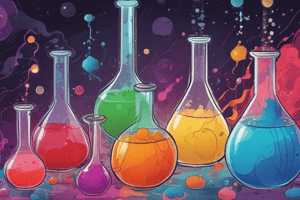Podcast
Questions and Answers
What is the scale of acidity?
What is the scale of acidity?
pH
What is H₃O⁺ commonly known as?
What is H₃O⁺ commonly known as?
hydronium
What is formed from the reaction of an acid and a base?
What is formed from the reaction of an acid and a base?
salt
What is the procedure to determine the concentration of an acid or base?
What is the procedure to determine the concentration of an acid or base?
What type of acid consists of only two elements?
What type of acid consists of only two elements?
What do you call a solution that resists changes in pH?
What do you call a solution that resists changes in pH?
What is a substance that forms hydronium ions in water according to Arrhenius?
What is a substance that forms hydronium ions in water according to Arrhenius?
What happens when an acid dissolves in water?
What happens when an acid dissolves in water?
What changes color at the endpoint of titration?
What changes color at the endpoint of titration?
What is the reaction of an acid with a base called?
What is the reaction of an acid with a base called?
According to Brønsted-Lowry, an acid is a ___ donor.
According to Brønsted-Lowry, an acid is a ___ donor.
What produces hydroxide ions in an aqueous solution according to Arrhenius?
What produces hydroxide ions in an aqueous solution according to Arrhenius?
According to Brønsted-Lowry, a base is a proton ___.
According to Brønsted-Lowry, a base is a proton ___.
What can act as either an acid or a base?
What can act as either an acid or a base?
What are the pairs that differ only by a proton called?
What are the pairs that differ only by a proton called?
What is it called when equivalent amounts of H⁺ and OH⁻ have reacted in a titration?
What is it called when equivalent amounts of H⁺ and OH⁻ have reacted in a titration?
An acid with a small K₀ value would be a ___ acid.
An acid with a small K₀ value would be a ___ acid.
What is the reaction of an ion with H₂O to produce H⁺(aq) + OH⁻(aq) called?
What is the reaction of an ion with H₂O to produce H⁺(aq) + OH⁻(aq) called?
Flashcards
pH Scale
pH Scale
A measure of the acidity or alkalinity of a solution. It usually ranges from 0 to 14, with lower values indicating higher acidity and higher values indicating higher alkalinity. pH 7 represents neutrality.
Hydronium Ion (H₃O⁺)
Hydronium Ion (H₃O⁺)
An ion formed when an acid donates a proton (H⁺) to a water molecule. It is a key species involved in acid-base reactions.
Salt Formation
Salt Formation
A compound formed when the positive ions of a base combine with the negative ions of an acid, effectively neutralizing their reactions.
Titration
Titration
Signup and view all the flashcards
Binary Acids
Binary Acids
Signup and view all the flashcards
Buffer Solutions
Buffer Solutions
Signup and view all the flashcards
Arrhenius Acid
Arrhenius Acid
Signup and view all the flashcards
Ionization Process
Ionization Process
Signup and view all the flashcards
Indicator
Indicator
Signup and view all the flashcards
Neutralization Reaction
Neutralization Reaction
Signup and view all the flashcards
Proton Donor
Proton Donor
Signup and view all the flashcards
Proton Acceptor
Proton Acceptor
Signup and view all the flashcards
Amphoteric Substances
Amphoteric Substances
Signup and view all the flashcards
Conjugate Pairs
Conjugate Pairs
Signup and view all the flashcards
Titration Endpoint
Titration Endpoint
Signup and view all the flashcards
Weak Acids
Weak Acids
Signup and view all the flashcards
Hydrolysis Reaction
Hydrolysis Reaction
Signup and view all the flashcards
Study Notes
Acids and Bases Concepts
- pH Scale: Measures the acidity or alkalinity of a solution, with a range typically from 0 to 14.
- Hydronium Ion (H₃O⁺): The ion formed when an acid donates a proton to water; a key species in acid-base chemistry.
- Salt Formation: Result of the neutralization reaction between an acid and a base.
- Titration: A quantitative method to determine the concentration of an acid or base in a solution through controlled addition of a titrant.
Types of Acids and Bases
- Binary Acids: Acids composed of two elements, usually hydrogen and a non-metal (e.g., HCl).
- Buffer Solutions: Solutions that minimize changes in pH upon the addition of small amounts of acids or bases, essential for maintaining stable environments.
- Arrhenius Acid: Substances that release hydronium ions when dissolved in water.
- Ionization Process: The dissociation of an acid in water, leading to the formation of hydronium ions.
Chemical Reactions and Definitions
- Indicator: A substance that changes color at the endpoint of a titration, signaling the completion of the reaction.
- Neutralization Reaction: The process where an acid reacts with a base to form water and a salt, effectively reducing the pH to neutral.
Brønsted-Lowry Theory
- Proton Donor: An acid according to Brønsted-Lowry theory, characterized by its ability to donate protons (H⁺ ions).
- Proton Acceptor: A base in the Brønsted-Lowry system, which gains protons during reaction.
- Amphoteric Substances: Compounds that can function as either acids or bases depending on the context of the reaction.
Chemical Equilibrium Concepts
- Conjugate Pairs: Acid-base pairs that differ by one proton, illustrating the reversible nature of acid-base reactions.
- Titration Endpoint: Achieved when equivalent moles of H⁺ and OH⁻ have completely reacted, indicating that neutralization is complete.
Acid Strength
- Weak Acids: Acids with small equilibrium constants (K₀), illustrating limited dissociation in water.
- Hydrolysis Reaction: Interaction of an ion with water to produce H⁺ and OH⁻ ions, significant in various chemical and biological processes.
Studying That Suits You
Use AI to generate personalized quizzes and flashcards to suit your learning preferences.




